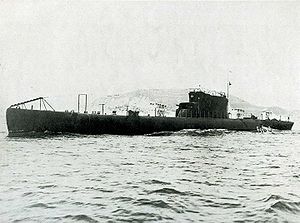Balilla-class submarine

Italian Submarine Domenico Millelire
|
|
| Class overview | |
|---|---|
| Name: | Balilla |
| Builders: | OTO |
| Operators: | |
| Succeeded by: | Ettore Fieramosca |
| Subclasses: | Humaytá |
| Completed: | 5 |
| Lost: | 1 |
| Retired: | 4 |
| General characteristics | |
| Type: | Submarine |
| Displacement: |
|
| Length: | 86.5 m (284 ft) |
| Beam: | 7.8 m (26 ft) |
| Draught: | 4.7 m (15 ft) |
| Propulsion: | |
| Speed: |
|
| Range: | 13,000 nmi (24,000 km; 15,000 mi) at 10 knots (19 km/h) |
| Test depth: | 400 ft (120 m) |
| Complement: | 77 |
| Armament: |
|
The Balilla-class were the first submarines to be built for the Italian navy following the end of World War I. They were large ocean-going cruiser submarines designed to operate in the Indian Ocean based in Italy's East African colonies. The design was double-hulled and based on the German Type UE 2 U-boats, one of which, U-120 was supplied to the Italians as a war reparation. A 425 horsepower (317 kW) auxiliary diesel engine was installed as an extra generator.
During the war, the boats were stationed in the Mediterranean in 1940 but proved too large to be effective patrol submarines. Their only success was the sinking of the British submarine HMS Triad by Enrico Toti on 15 October 1940. After 1941 they were used as transport submarines to supply Italian forces in North Africa. The surviving boats were scrapped after the war.
One submarine, Humaytá, was built for the Brazilian navy to a modified design.
The design of the Ballila-class consisted of a strong double-hull which gave the ships a maximum diving depth of 350 ft (110 m), though Domenico Millelire reached 400 ft (120 m) in trials. The boats displaced 1,427 tons surfaced and 1874 tons submerged. They were 86.5 m (284 ft) long with a beam of 7.8 m (26 ft) and a draught of 4.7 m (15 ft). The boats were considered to have poor stability.
The submarines were powered by 2 Fiat diesels for surface cruising and 2 Savigliano electric motors for use while submerged driving 2 shafts. These created 4,900 bhp (3,700 kW) and 2,200 hp (1,600 kW) respectively. The second diesel engine was for auxiliary purposes and for recharging the batteries, novel at the time of the boats' construction. This gave the ships a speed of 16 knots (30 km/h; 18 mph) surfaced and 7 knots (13 km/h; 8.1 mph) submerged. However the initial design called for the ability to reach speeds of 17.5 knots (32.4 km/h; 20.1 mph) surfaced and 8.9 knots (16.5 km/h; 10.2 mph) and the subs never reached these marks. The Ballila-class boats had a range of 13,000 nmi (24,000 km; 15,000 mi) at 10 knots (19 km/h).
...
Wikipedia
